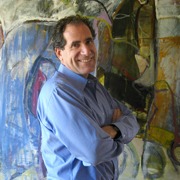
Distribution | Film Festivals | Filmmaking | Interviews | Screenplay Doctor
Experimenting in the Digital Era: An Interview with Jon Gartenberg
Written by Susan Kouguell | Posted by: NewEnglandFilm.com
With the Tribeca Film Festival in New York City just calling it a wrap, it was the perfect time to speak with one of its programmers, Jon Gartenberg, President of Gartenberg Media Enterprises ( GME) to offer insight into experimental and digital filmmaking, current trends, curating festivals, and more.
Jon Gartenberg (jon@gartenbergmedia.com) has worked extensively over the course of his career on the preservation, distribution, and programming of experimental films. Since 2003, Gartenberg has been a programmer for the Tribeca Film Festival, collaborating on the section of Restored & Rediscovered films, as well as curating a strong representation of independent and experimental works, a number of which have garnered festival prizes. For 18 years he worked as a curator in the film archive of The Museum of Modern Art in New York, where he acquired, catalogued, and preserved films for the permanent collection. His signature projects include restoring the films of Andy Warhol and editing the published catalog of MOMA’s archival film collection. On an international level, Gartenberg has curated numerous film exhibitions, lectured extensively, and written many articles relating to film history and archiving, ranging in subject from D.W. Griffith to experimental cinema. He also advises cutting-edge filmmakers on the economics of experimental film distribution and exhibition, expanding their visibility in the marketplace, and authored an article about this subject (“The Fragile Emotion”) for the book entitled Swimming Upstream (2008).
Susan Kouguell: In the ten years that you have been a programmer for the Tribeca Film Festival, what are some of the significant changes and trends that you have seen in independent and experimental films?
Jon Gartenberg: The most profound shift has been the movement toward digital filmmaking. Perceptually, this means a significant shift away from the chemical texture of the film grain and toward the electronic nature of digital pixels. Veteran filmmakers such as James Benning and Ernie Gehr have abandoned the 16mm celluloid universe in favor of digital production. Even in those cases where filmmakers still shoot on Super8mm, 16mm, or even 35mm celluloid film, their works are most often finished for exhibition in a digital format.
SK: What types of distribution opportunities are there for experimental filmmakers?
Gartenberg: Even though experimental films operate primarily in an economic system separate from the commercial industry, there are, nevertheless, a variety of distribution opportunities available to experimental filmmakers. Primary among these are artist-driven film and video cooperatives that exist worldwide, including The New York Film-Makers’ Coop in New York City and Light Cone in Paris.
DVD and Blu-ray editions of works by experimental filmmakers (such as Abigail Child, Germaine Dulac, and Rose Lowder) have been produced by a variety of international boutique publishers for both home video consumption and educational use. For example, my company ( Gartenberg Media Enterprises) imports and distributes a number of these editions exclusively to universities in the United States and Canada.
Finally, television broadcasters in the US and abroad (including the Sundance Channel and Arte) have shown selected works by experimental and independent filmmakers.
Concurrent with these distribution mechanisms, experimental films are exhibited at film festivals as well as museums, universities, libraries, galleries and alternative spaces.
For more information about all these distribution options, please refer to my article entitled, “The Fragile Emotion” that was originally published in Swimming Upstream: A Lifesaving Guide to Short Film Distribution.
SK: With the advances of digital filmmaking and the ease in which one can shoot a film, post it online, and get work seen by a vast virtual audience — often all within hours — how do you feel this has changed filmmaking, filmmakers’ voices, and the face of distribution?
Gartenberg: The universal possibilities of DIY digital filmmaking and distribution through the Internet has resulted in a great increase in the quantity of work that is readily available. This creates a much greater possibility for an individual filmmaker to reach a potentially wider audience than ever before.
At the same time, I do not think this has given rise to an improvement in the quality of individual works made available in this manner to the general public. In my view, experimental filmmakers are first and foremost formally trained visual artists who labor extensively on creating their individual cinematic visions. As a curator, I am more focused on exposing those artists who demonstrate a consciousness about both the structuring and deconstruction of narrative, especially when incorporating abstraction in their work.
There is also an issue of scale. At the Tribeca Film Festival, experimental films are shown in commercial theaters alongside more mainstream festival fare. It is exciting for me to see these artists’ wonderful creations in all their rich and varied textures, projected onto a large, theatrical screen. Once, a filmmaker whose work I programmed there remarked to me that he hadn’t even noticed a certain detail in the action he filmed until he saw the image on the big screen at the Tribeca Film Festival.
Finally, there is an issue of duration, which is a predicate of experimental filmmaking practice. In a theatrical setting, there is a captive audience to experience the arc of the work in the manner in which it was structured by the filmmaker. With the proliferation of the internet, the viewer is more free to sample sections of the work, an action that undermines the careful, often nonlinear, structuring of these films by their artists.
SK: When curating and programming film festivals do you look at online sites such as YouTube and Vimeo to scout work? If so, what are your thoughts on this and have you found any talent through these sites? If not, is there a particular reason for you not to seek films in this way?
Gartenberg: Based on my response to the previous question, I do not scour You Tube for experimental works. I do, however, focus on Vimeo sites that I am directed to by individual filmmakers or other programmers. It is an excellent way to initially see a film without forcing the filmmakers to go to the expense of shipping DVDs.
SK: Over the years, experimental filmmakers working in Super-8 and 16 mm often incorporated the ‘accidents’ of shooting on film, as well as actual experimentation of the celluloid, the lighting, the cameras, and so on, to further enhance and investigate their voice and vision. While digital filmmaking has certainly enabled the filmmaking process to be more accessible and less expensive, have you found that filmmakers’ voices have been compromised in any way?
Gartenberg: I agree with you completely that the filmmaking “accidents” often become an integral part of the final creative result. This is one of the major distinctions between experimental films and commercial cinema (which promotes seamlessness,) whereas avant-garde films advocate for discontinuity and disruption. In my preservation work on avant-garde films, I am very conscious of embedding these “accidents” into the restoration process.
The most talented avant-garde filmmakers have successfully transitioned from the “accidents” inherent in celluloid filmmaking, to highlighting the “accidents” inherent in digital cinematography. An illustrative example of this is Ken Jacobs’s ONTIC ANTICS (2005), in which the iconic images of Laurel and Hardy struggle to resolve themselves against the prominence of the digital pixels.
SK: In your opinion, who are the most influential international experimental filmmakers and why?
Gartenberg: Across the entire span of film history, there have been a myriad of experimental filmmakers who have been extremely influential in the manner in which their individual creative voices have deeply illuminated the human condition. Among them are James Broughton and Warren Sonbert.
James Broughton was a visionary poet and filmmaker who emerged from the artistic renaissance that flowered in post WWII San Francisco. In this centennial year of his birth, a creative documentary by directors Stephen Silha and Eric Slade (together with editor Dawn Logsdon), entitled BIG JOY: THE ADVENTURES OF JAMES BROUGHTON, has been making the festival rounds, including showings at SXSW and Tribeca. (Broughton’s films were historically so important that I acquired them for The Museum of Modern Art’s permanent collection when I worked there as a film archivist).
Warren Sonbert began his career as a film student in the 1960’s at New York University; in addition, he was involved with Warhol’s Factory scene. He then went on to make masterful, symphonic montage works that united the world of human gestures. I have worked extensively on a project to restore his entire body of work that is now held at the Academy of Motion Picture Arts and Sciences, as well as Harvard Film Archive. I have curated a retrospective touring show of his career through Light Cone, the European distributor of his films. For more information, see: http://lightcone.org/pdf/sonbert/w.sonbert-brochure.pdf.
SK: There appears to be more and more film festivals each year. What are your thoughts about this explosion of festivals; do you think this is advantageous to filmmakers and audiences, or is the market getting too flooded and therefore audiences do not take these events seriously and in turn, attendance suffers?
Gartenberg: My own view is that with the rapid proliferation of festivals, there is ever-increasing pressure on filmmakers to choose between one festival or another because of premiere status. For experimental filmmakers, I think this is counterproductive, since their films to a great degree have little commercial viability, and the most important objective is for their works to be seen by as many festival audiences in as many different venues and cities as possible.
SK: What advice can you offer to independent filmmakers about expanding their visibility in the competitive film marketplace?
Gartenberg: Different filmmakers may have different objectives for their films (i.e., exposure through the festival route, DIY distribution, gallery and museum exhibition, and television broadcast). Thus, it’s important to align the exposure of the work consistent with the different stakeholders in each of these distinct paths toward getting their work recognized.
SK: Any final words of wisdom you would like to share?
Gartenberg: In this era of global branding and marketing, I hope your readers are as inspired as I am by the individual voices of the global community of experimental artists. As one example of this, I recently curated a program of experimental shorts for the Tribeca Film Festival entitled, “Let There Be Light: The Cycles of Life.” In this program, I brought together a diverse group of contemporary experimental films (comprising animation, live action, and found footage works) from around the world. My selection of films highlighted the unique manner in which these filmmakers are acutely aware of the quality of light that informs their artistic practice. They seek inspiration from the power of the sun, the reflections of the moon, and from the luminosity emitted by artificial light sources. In linking their own vision directly to that of the eye of the camera, these artists created brilliant, moving works that both illuminate the human condition and reflect the cycles of life.
Award-winning screenwriter and filmmaker Susan Kouguell teaches screenwriting and film at Tufts University, and is chairperson of Su-City Pictures East, LLC, a motion picture consulting company founded in 1990 where she works with over 1,000 writers, filmmakers, and film executives worldwide ( www.su-city-pictures.com; su-city-pictures.blogspot.com). Susan wrote The Savvy Screenwriter: How to Sell Your Screenplay (and Yourself) Without Selling Out! (St. Martin’s Griffin) and SAVVY CHARACTERS SELL SCREENPLAYS! A comprehensive guide to crafting winning characters with film analyses and screenwriting exercises, which is available at $1.00 off by clicking on www.createspace.com/3558862 and using DISCOUNT CODE: G22GAZPD. To order the Kindle version: http://www.amazon.com/dp/B009SB8Z7M (discount code does not apply). To read an excerpt go to: https://www.createspace.com/Preview/1089452. Follow Susan at Su-City Pictures, LLC Facebook fan page and SKouguell Twitter page to receive more Savvy Tips.
Award-winning screenwriter and filmmaker Susan Kouguell teaches screenwriting and film at Tufts University, and is chairperson of Su-City Pictures East, LLC, a motion picture consulting company founded in 1990 where she works with over 1,000 writers, filmmakers, and film executives worldwide ( www.su-city-pictures.com; su-city-pictures.blogspot.com). Susan wrote The Savvy Screenwriter: How to Sell Your Screenplay (and Yourself) Without Selling Out! (St. Martin’s Griffin) and SAVVY CHARACTERS SELL SCREENPLAYS! A comprehensive guide to crafting winning characters with film analyses and screenwriting exercises, which is available at $1.00 off by clicking on www.createspace.com/3558862 and using DISCOUNT CODE: G22GAZPD. To order the Kindle version: http://www.amazon.com/dp/B009SB8Z7M (discount code does not apply). To read an excerpt go to: https://www.createspace.com/Preview/1089452. Follow Susan at Su-City Pictures, LLC Facebook fan page and SKouguell Twitter page to receive more Savvy Tips.










